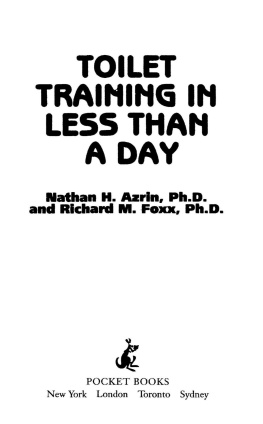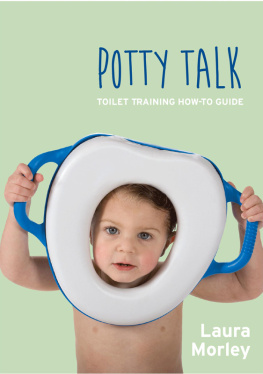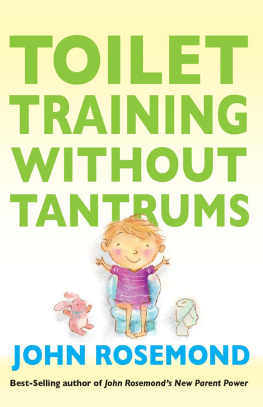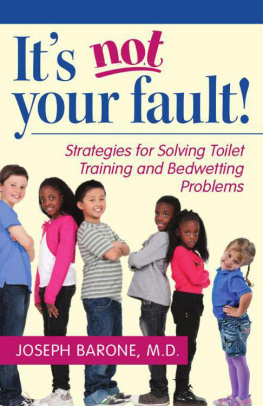Nathan Azrin - Toilet Training in Less Than a Day
Here you can read online Nathan Azrin - Toilet Training in Less Than a Day full text of the book (entire story) in english for free. Download pdf and epub, get meaning, cover and reviews about this ebook. publisher: Gallery Books, genre: Children. Description of the work, (preface) as well as reviews are available. Best literature library LitArk.com created for fans of good reading and offers a wide selection of genres:
Romance novel
Science fiction
Adventure
Detective
Science
History
Home and family
Prose
Art
Politics
Computer
Non-fiction
Religion
Business
Children
Humor
Choose a favorite category and find really read worthwhile books. Enjoy immersion in the world of imagination, feel the emotions of the characters or learn something new for yourself, make an fascinating discovery.
- Book:Toilet Training in Less Than a Day
- Author:
- Publisher:Gallery Books
- Genre:
- Rating:4 / 5
- Favourites:Add to favourites
- Your mark:
- 80
- 1
- 2
- 3
- 4
- 5
Toilet Training in Less Than a Day: summary, description and annotation
We offer to read an annotation, description, summary or preface (depends on what the author of the book "Toilet Training in Less Than a Day" wrote himself). If you haven't found the necessary information about the book — write in the comments, we will try to find it.
Toilet Training in Less Than a Day — read online for free the complete book (whole text) full work
Below is the text of the book, divided by pages. System saving the place of the last page read, allows you to conveniently read the book "Toilet Training in Less Than a Day" online for free, without having to search again every time where you left off. Put a bookmark, and you can go to the page where you finished reading at any time.
Font size:
Interval:
Bookmark:
Thank you for downloading this Gallery Books eBook.
Join our mailing list and get updates on new releases, deals, bonus content and other great books from Gallery Books and Simon & Schuster.
C LICK H ERE T O S IGN U P
or visit us online to sign up at
eBookNews.SimonandSchuster.com
We hope you enjoyed reading this Gallery Books eBook.
Join our mailing list and get updates on new releases, deals, bonus content and other great books from Gallery Books and Simon & Schuster.
C LICK H ERE T O S IGN U P
or visit us online to sign up at
eBookNews.SimonandSchuster.com

is clearly and sympathetically written, with explicit drawings to demonstrate every single step in the training procedure. Enjoy, as thousands of parents have, the many rewards you can expect from this wonderful new teaching technique.
But as important as the new method is for parents, the major concern is for the child. Spanking and anger are definitely excluded. During the training the child is hugged, praised, given treats, and made the center of loving attention.
Typically, at the end of training, the child is filled with pride and a sense of accomplishment. This increased happiness of the child is the most gratifying aspect of the Azrin- Foxx technique.

POCKET BOOKS, a division of Simon & Schuster, Inc.
1230 Avenue of the Americas, New York, NY 10020
www.SimonandSchuster.com
Copyright 1974 by Nathan H. Azrin and Richard M. Foxx
All rights reserved, including the right to reproduce this book or portions thereof in any form whatsoever. For information address Simon & Schuster Inc., 1230 Avenue of the Americas, New York, NY 10020
ISBN 13: 978-0-671-69380-0
ISBN 13: 978-1-476-79233-0(ebook)
ISBN 10: 0-671-69380-8
First Pocket Books printing June 1976
POCKET and colophon are registered trademarks of Simon & Schuster Inc
Many individuals assisted in the development of the new training procedure. R. C. Steck and P. Levi-son provided the necessary administrative support and encouragement. Afton Jarvis and Angela Foss served as trainers for many of the children in the formal study. The development of the toilet-training procedure was made possible by the Division of Research Services of the Illinois Department of Mental Health. Preliminary sketches were drawn by Joanna Flores. Tim and Greg Hildebrandt drew the illustrations that appear in this book.
We are especially appreciative of the cooperation and support of the many mothers and children who participated in the toilet-training project during its initial development.
The development of the new method of toilet training has been an exciting adventure for us.
The story of how the new procedure came to be developed is best told if we describe first who we are. We are psychologists who study what is involved in learning and how learning can be made more rapid. Like many other psychologists who study the learning process, we felt obligated to apply new discoveries about learning to those persons who suffer the most from the problemnamely, the profoundly retarded persons who have such a deficit in learning ability that they must be confined to an institution. Typically, the profoundly retarded person is so helpless that he cannot dress himself, nor feed himself properly, nor speak, nor toilet himself. He is perhaps the most ignored and least fortunate element in human society.
In our research with the profoundly retarded, our objective was to elevate the level of functioning and happiness of the retarded. The results were gratifying. The profoundly retarded could learn, by the newly developed procedures, to eat as well as normal persons; they could be motivated by special motivational procedures to be enthusiastic and eager; they could learn to refrain from physical aggression; and they could be taught to groom and dress themselves properly. A message was becoming clear: the plight of the profoundly retarded person was not hopeless; he could be taught to function in a more normal manner by intensive training programs.
One of the major unsolved problems for the profoundly retarded was toileting; most of them are incapable of toileting themselves even as adults. Our efforts with toilet training of the retarded yielded results as gratifying as the results for the other activities. We devised a method that was successful in training about 95 percent of them, and in an average time of only three days, to toilet all by themselves. Forty years of pants wetting and soiling could be ended by a few days of intensive training.
The next stage in our research was to develop toilet-training procedures for persons who were only moderately retarded or not retarded and who had ample learning ability. For if the profoundly retarded could be taught in about three days, mildly retarded or normal children should be able to learn even faster. We therefore devised a new training procedure, one that emphasized language ability, imagination, imitation, verbal rehearsal, and verbal instructions in addition to learning by association and learning by reward. The results obtained with normal children exceeded our most optimistic expectations. The average child of normal intelligence required less than half a day of training. Within three or four hours of intensive training, the young child had learned to toilet himself, was motivated to do so, and, like the retarded adult, had taken a giant step toward feeling independent and in control of his own destiny.
The story did not end with this rapid method of training normal children. We asked ourselves whether the new features of the procedure for normal children might not also be useful for some of those who are retarded. We found that they were. Many mildly retarded children could use the language-dependent parts of the new procedure and could thereby be trained in less than a day.
We had come full circle. In an attempt to elevate retarded adults to more normal functioning, we had devised an effective procedure for teaching them independence in toileting. Extension of the approach to normal children was successful, but required many changes in technique. These changes, in turn, proved useful when the training method was applied to retarded children.
No single theoretical orientation is followed exclusively. The procedure borrows heavily from the many different approaches to children. We have utilized the psychoanalytic emphasis on the possible effect of harsh toilet training on later personality by making the experience a pleasant one. We have taken advantage of the medical knowledge about toilet training by not advising training until the child is physically ready and free of medical problems. We have acknowledged the importance of Pavlovian learning by ensuring the association of sphincter relaxation with the potty-chair stimuli. We have incorporated the role of operant learning by arranging for many types of reinforcers to follow the desired responses. We have included imitation and social influence by use of a doll that wets and by making the training a social experience. The new method is not an application of any one theory of child training, but rather a combination of the procedures suggested by the many different approaches to children. No gimmick or gadget causes the rapid learning. The child learns so fast because we have used so many factors to make learning pleasant, simple, and exciting.
Next pageFont size:
Interval:
Bookmark:
Similar books «Toilet Training in Less Than a Day»
Look at similar books to Toilet Training in Less Than a Day. We have selected literature similar in name and meaning in the hope of providing readers with more options to find new, interesting, not yet read works.
Discussion, reviews of the book Toilet Training in Less Than a Day and just readers' own opinions. Leave your comments, write what you think about the work, its meaning or the main characters. Specify what exactly you liked and what you didn't like, and why you think so.







